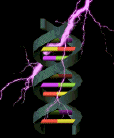|

|
How Could Life Have Arisen on Earth? Module written by Paul G. Jasien, Stanley
L. Miller |
Session 1: How could life have arisen on earth?
Introduction
Exploration 1A: What are your initial ideas?
Exploration 1B: What are the requirements of life?
Exploration 1C: Where do we search for signs of life?
Session 2: Under what conditions did life arise?
The Primordial Environment
Exploration 2A: What are your initial ideas?
Oxidizing and Reducing Atmospheres
Exploration 2B: What processes control the temperature of the earth?
Energy Release and Absorption
Exploration 2C: Can we make a simple model for the amount of O2
on the primitive earth?
Steady State Processes
Session 3: How can the molecules of life be made?
The Building Blocks
Exploration 3A: What are your initial ideas?
Small Molecule Chemistry
Exploration 3B: What do molecules look like in 3-D?
Optical Isomers and Molecular Interactions
Exploration 3C: Could life have arisen in space?
Exploration 3D: Can we simulate the conditions of the early earth in the
laboratory?
High Energy Chemical Reactions
Exploration 3E: How can we simulate the origin of life on a computer?
Session 4: What do we mean by a "stable" molecule?
A Question of Time
Exploration 4A: What are your initial ideas?
Exploration 4B: Can a molecule be both stable and unstable?
Thermodynamics and Stability
Exploration 4C: Are amino acids "stable"?
Concentration vs. Time Graphs
Exploration 4D: How can we quantitate the rate of a reaction?
Reaction Rates
Session 5: Can life have arisen from a poison?
Rate Laws
Exploration 5A: What are your initial ideas?
Concentration and reaction rates
Exploration 5B: How can we mathematically represent the reaction rate?
Rate Laws
Exploration 5C: What could have happened in a tidal pool?
Concentration Effects on Reaction Rates
Exploration 5D: How can the rate law be determined?
The Method of Initial Rates
Exploration 5E: How can you find the rate law for the formation of adenine?
Experimental Design and Rate Laws
Exploration 5F: How can we relate rate laws to reaction mechanisms?
Mechanisms and Rate Laws
Session 6: How can prebiotic reaction rates be increased?
Temperature and Rates
Exploration 6A: What are your initial ideas?
Temperature and Reaction Rates
Exploration 6B: What molecular level model can account for reaction rate
changes?
Activation Energy and Chemical Reactions
Exploration 6C: Could life have arisen at high temperature?
The Arrhenius Equation
Exploration 6D: How can certain molecules increase reaction rates?
Catalysts and Chemical Reactions
Exploration 6E: How can optical isomers be interconverted?
Session 7: Can we determine when life arose?
Kinetics and Nuclear Decay
Exploration 7A: What are your initial ideas?
Radioactive Elements
Exploration 7B: Can we quantitatively analyze a first order reaction?
First-Order Integrated Rate Law
Exploration 7C: How can we find the age of rocks?
Half-lives
Session 8: How can we measure the rate of hydrolysis of
cytosine to uracil in the laboratory?
Mutations and Chemical Kinetics
Experimental Determination of k and Ea
Session 9: Putting it all together
Where should we look for evidence of extraterrestrial life?
Copyright © 2004 by the trustees of Beloit College and the Regents of the
University of California. This Module has been
developed under the direction of the ChemLinks Coalition, headed by Beloit College,
and the ModularChem Consortium, headed by the University of California at Berkeley.
This material is based upon work supported by the National Science Foundation
grants No. DUE-9455918 and DUE-9455924. Any opinions, findings, and conclusions
or recommendations expressed in this material are those of the authors and do
not necessarily reflect the views of the National Science Foundation, Beloit
College, or the Regents of the University of California.
Published through exclusive license with W.
W. Norton.
How Could LIfe Have Arisen on Earth? ISBN 0-393-92436-X
Origin of Life | ChemConnections